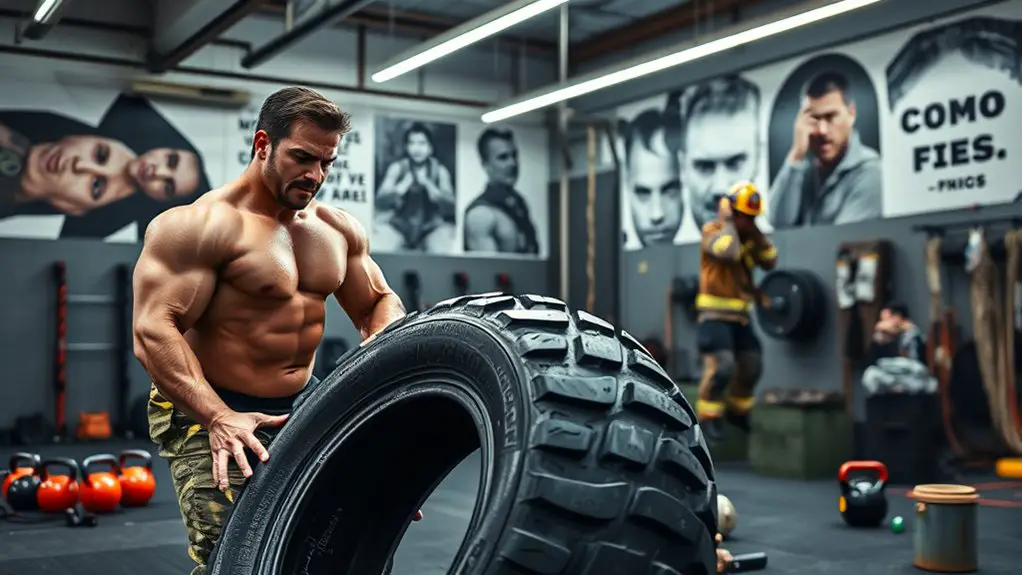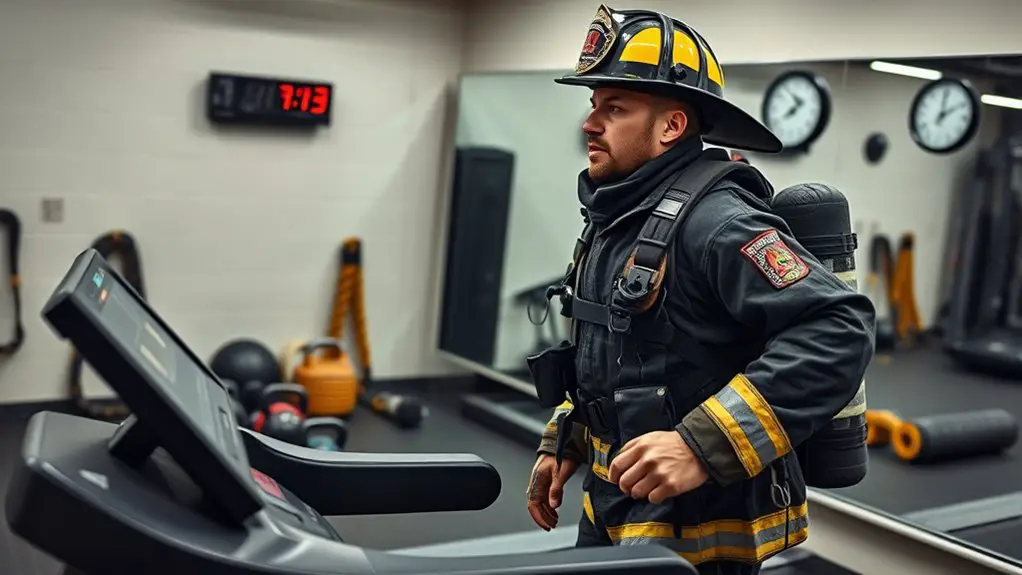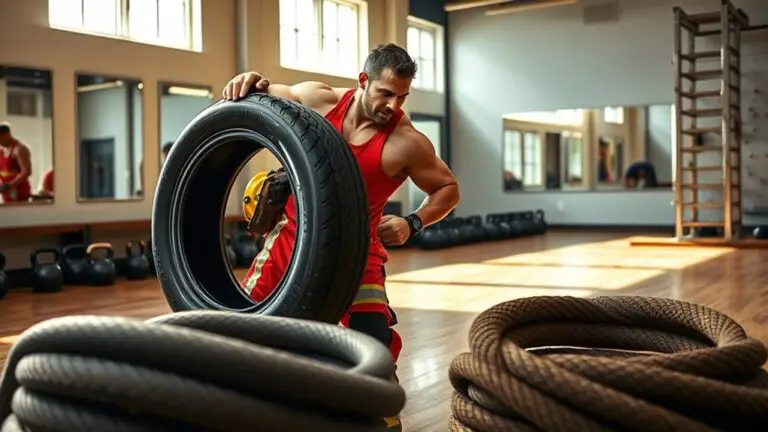The Best Gym Workouts for Firefighters

The best gym workouts for firefighters combine functional strength training, HIIT, and endurance conditioning. Focus on exercises like squats, deadlifts, and kettlebell swings to build strength. Add sprinting and cycling for HIIT to boost your heart health and efficiency. Include running and circuit workouts to enhance stamina. Don’t forget agility drills for quickness and flexibility exercises to prevent injuries. By incorporating these elements, you’ll optimize your fitness for the job’s demands. There’s more to discover about fine-tuning your regimen!
Functional Strength Training

When it comes to preparing for the demands of firefighting, functional strength training is vital. This type of training focuses on building overall strength through movements that mimic the challenges you’ll face on the job. By incorporating resistance training into your routine, you can improve not just your physical power but also your core stability, which is essential for maintaining balance and preventing injuries in high-pressure situations.
Exercises like squats, deadlifts, and kettlebell swings target multiple muscle groups, enhancing your ability to lift heavy equipment or maneuver in tight spaces. Additionally, integrating stability exercises such as planks or medicine ball rotations helps develop a strong core, providing you with the foundation needed for effective movement. Prioritizing functional strength training guarantees you’re not only fit but also safer on the job, allowing you to respond to emergencies with confidence and efficiency. Including front squat alternatives in your training can help maintain joint health while building strength.
High-Intensity Interval Training (HIIT)
High-Intensity Interval Training (HIIT) can be a game-changer for firefighters looking to boost their cardiovascular fitness and endurance. With HIIT, you alternate between short bursts of intense exercise and periods of rest or lower-intensity activity. This approach not only saves time but also maximizes your workout efficiency, making it easier to fit training into your busy schedule.
The HIIT benefits are numerous; it helps improve your heart health, increases metabolism, and enhances your ability to perform demanding tasks on the job. You can incorporate various HIIT techniques, like sprinting, cycling, or bodyweight exercises, to keep workouts engaging.
Always prioritize safety by ensuring proper form and listening to your body during workouts. Start slow and gradually increase intensity as your fitness level improves. By integrating HIIT into your routine, you’ll be better prepared for the physical challenges that come with being a firefighter.
Endurance Conditioning

While firefighters often face intense physical demands, endurance conditioning is essential for sustaining energy levels throughout long shifts. Building your cardiovascular endurance through consistent stamina training can make a significant difference in your performance and safety. When you’re out on the field, being able to maintain your energy can help you respond effectively in high-pressure situations.
Incorporate activities like running, cycling, or swimming into your routine to boost your endurance. Aim for longer sessions at a moderate pace to enhance your aerobic capacity. Additionally, consider adding circuit-style workouts that keep your heart rate elevated while mimicking the physical tasks you’ll encounter on the job. Skipping rope can serve as a versatile exercise that offers both aerobic and anaerobic benefits, enhancing your overall fitness and stamina.
Agility and Flexibility Drills
Building on your endurance training, agility and flexibility drills play an essential role in a firefighter’s workout regimen. These exercises help enhance your overall performance and guarantee you can respond safely in emergency situations. Start by incorporating dynamic stretches, which warm up your muscles and improve your range of motion. Think leg swings, arm circles, and torso twists to get your body ready for action.
Next, focus on balance exercises, like single-leg stands or stability ball workouts, to strengthen your core and improve coordination. These skills are critical when maneuvering uneven terrain or carrying heavy equipment.
Incorporate agility ladders or cone drills to sharpen your quickness and footwork, significant for maneuvering in tight spaces. Remember, agility and flexibility aren’t just about speed; they’re about maintaining control and preventing injuries. By prioritizing these drills, you’ll boost your performance while safeguarding your safety on the job.
Recovery and Mobility Focused Workouts

Recovery and mobility-focused workouts are essential for firefighters, as they help your body recover from intense training and prepare for the physical demands of the job. Incorporating techniques like foam rolling and active stretching can greatly enhance your flexibility and reduce muscle soreness. It’s also important to be aware that improper form during activities, such as skipping rope, can lead to lower back pain.
Here’s a simple routine you can follow:
| Exercise | Duration | Benefits |
|---|---|---|
| Foam Rolling | 10 minutes | Reduces muscle tightness |
| Active Stretching | 15 minutes | Improves range of motion |
| Dynamic Warm-up | 10 minutes | Prepares muscles for activity |
| Cool Down | 5 minutes | Aids in recovery |
Prioritizing these workouts guarantees that you’re not only ready for the challenges of firefighting but also maintaining your overall health and safety. Make recovery a regular part of your training to perform at your best!
Frequently Asked Questions
What Should Firefighters Eat to Complement Their Workout Regimen?
Did you know that proper meal timing can boost workout performance by up to 20%? To complement your regimen, focus on nutrient balance. Aim for a mix of complex carbs, lean proteins, and healthy fats in your meals, especially before and after workouts. Eating at the right times helps fuel your body and aids recovery, ensuring you stay safe and strong for your demanding role. Remember, what you eat is just as important as how you train.
How Often Should Firefighters Train Each Week?
You should aim to train at least five days a week to build strength and improve cardiovascular endurance. Incorporating both strength training and cardio into your routine is essential for overall fitness. This frequency helps you stay prepared and safe in demanding situations. Be sure to listen to your body and allow for adequate rest and recovery, especially after intense workouts. Consistency is key, but safety should always come first.
Can Firefighters Workout Outdoors Effectively?
Can you really maximize your training outdoors? Absolutely! Outdoor training can be incredibly effective, especially when focusing on functional fitness. Think about it: you’re simulating real-life scenarios while enjoying fresh air. Just remember to prioritize safety—choose a suitable environment, monitor the weather, and pay attention to your surroundings. With the right approach, you can enhance your strength and endurance outside, proving that the gym isn’t the only place to achieve your fitness goals.
What Is the Best Time of Day to Train?
The best time of day to train really depends on your schedule and energy levels. Morning workouts can boost your metabolism and keep you alert throughout the day. However, if you find evenings more convenient, evening routines can help you unwind and relieve daily stress. Whichever you choose, just make sure you’re prioritizing your safety by warming up properly and staying hydrated. Listen to your body, and find what works best for you!
How Can Firefighters Prevent Injuries During Workouts?
Think of your body as a finely-tuned machine; it needs regular maintenance to run smoothly. To prevent injuries during workouts, you’ve got to prioritize injury prevention techniques. Start with thorough warm-up routines that prepare your muscles and joints for action, just like a race car warming up before hitting the track. Don’t skip stretching and listen to your body—if something feels off, take a break. Safety first, always!





